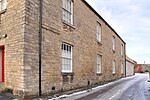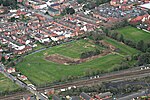Sleaford is a market town and civil parish in the North Kesteven district of Lincolnshire, England. Centred on the former parish of New Sleaford, the modern boundaries and urban area include Quarrington to the south-west, Holdingham to the north and Old Sleaford to the east. The town is on the edge of the fertile Fenlands, 11 miles (18 kilometres) north-east of Grantham, 16 mi (26 km) west of Boston, and 17 mi (27 km) south of Lincoln. Its population of 17,671 at the 2011 Census made it the largest settlement in the North Kesteven district; it is the district's administrative centre. Bypassed by the A17 and the A15, it is linked to Lincoln, Newark, Peterborough, Grantham and King's Lynn.
The first settlement formed in the Iron Age where a prehistoric track crossed the River Slea. It was a tribal centre and home to a mint for the Corieltauvi in the 1st centuries BC and AD. Evidence of Roman and Anglo-Saxon settlement has been found.
During the period of Danelaw, the area was actively populated. There are not only many names of places in the area that end in -by or -thorpe, but also the -gate ending of streets in Sleaford itself (North Gate, Eastgate, Westgate, South Gate and Watergate). All these bear witness to a population with a profoundly Scandinavian origin.
The medieval records differentiate between Old and New Sleaford, the latter emerging by the 12th century around the present-day market place and St Denys' Church; Sleaford Castle was also built at that time for the Bishops of Lincoln, who owned the manor. Granted the right to hold a market in the mid-12th century, New Sleaford developed into a market town and became locally important in the wool trade, while Old Sleaford declined.
From the 16th century, the landowning Carre family kept tight control over the town – it grew little in the early modern period. The manor passed from the Carre family to the Hervey family by the marriage of Isabella Carre to John Hervey, 1st Earl of Bristol in 1688. The town's common land and fields were legally enclosed by 1794, giving ownership mostly to the Hervey family. This coincided with canalisation of the Slea. The Sleaford Navigation brought economic growth until it was superseded by the railways in the mid-1850s. In the 20th century, the sale of farmland around Sleaford led to the development of large housing estates.
Sleaford was mainly an agricultural town until the 20th century with a cattle market. Seed companies such as Hubbard and Phillips and Sharpes International were established in the late 19th century. The arrival of the railway made the town favourable for malting, but the industry has since declined. In 2011, the commonest occupations were in wholesale and retail trading, health and social care, public administration, defence and manufacturing. Regeneration of the town centre has helped to regenerate the earlier industrial areas, including construction of the National Centre for Craft & Design (The Hub) on an old wharf.










